| Pages:
1
..
7
8
9
10
11
..
14 |
DraconicAcid
International Hazard
    
Posts: 4332
Registered: 1-2-2013
Location: The tiniest college campus ever....
Member Is Offline
Mood: Semi-victorious.
|
|
I made it once, and I thought it smelled like celery.
Please remember: "Filtrate" is not a verb.
Write up your lab reports the way your instructor wants them, not the way your ex-instructor wants them.
|
|
|
TriiodideFrog
Hazard to Others
  
Posts: 108
Registered: 27-9-2020
Member Is Offline
|
|
Made sodium hydroxide and calcium carbonate from sodium carbonate and calcium hydroxide.
|
|
|
MidLifeChemist
Hazard to Others
  
Posts: 192
Registered: 4-7-2019
Location: West Coast USA
Member Is Offline
Mood: precipitatory
|
|
Interesting. I made sodium carbonate by putting baking soda into the oven.
|
|
|
arkoma
Redneck Overlord
      
Posts: 1761
Registered: 3-2-2014
Location: On a Big Blue Marble hurtling through space
Member Is Offline
Mood: украї́нська
|
|
Quote: Originally posted by Bedlasky  | | Arkoma: How propyl salicylate smells like? I plan to make propyl benzoate or salicylate, I am not sure which one I'll pick. |
Similar to the methyl ester, but not as "strong". Smells good.
"We believe the knowledge and cultural heritage of mankind should be accessible to all people around the world, regardless of their wealth, social
status, nationality, citizenship, etc" z-lib
|
|
|
j_sum1
Administrator
       
Posts: 6320
Registered: 4-10-2014
Location: At home
Member Is Online
Mood: Most of the ducks are in a row
|
|
I have made ethyl salycilate before. It is really similar to methyl salycilate. Maybe not quite as feisty. I eould imagine that the propyl ester
follows trend.
Having said that, ester odours do present surprises.
|
|
|
Bedlasky
International Hazard
    
Posts: 1239
Registered: 15-4-2019
Location: Period 5, group 6
Member Is Offline
Mood: Volatile
|
|
Yesterday I tried to make sodium orthoperiodate by persulfate method from NaI. I started from KI, which I converted to NaI by precipitation of
potassium as bitartrate. Than I added 30 g of NaOH and 77,5 g of Na2S2O8 in small portions (after each addition quite exothermic reaction took place).
Than I heated it in hot water bath for 15 minutes, added 15g of NaOH and after that I heated it for 30 minutes. Than I added 100 mils of water to
dissolve all sulfate and heated it for 10 minutes. I allowed the solution to cool for several hours, decanted as much liquid as possible and added
another 50 mils of water, heated for a while and again let it cool. Just now I filtering the solid and wash it with ice cold distilled water.
|
|
|
arkoma
Redneck Overlord
      
Posts: 1761
Registered: 3-2-2014
Location: On a Big Blue Marble hurtling through space
Member Is Offline
Mood: украї́нська
|
|
Tossed some n-propyl alcohol, citric acid, and few drops h2so4 into a RBF, Refluxing now.
"We believe the knowledge and cultural heritage of mankind should be accessible to all people around the world, regardless of their wealth, social
status, nationality, citizenship, etc" z-lib
|
|
|
j_sum1
Administrator
       
Posts: 6320
Registered: 4-10-2014
Location: At home
Member Is Online
Mood: Most of the ducks are in a row
|
|
Your target is an ester I presume.
I am nearing the end of preparing some silver nitrate. I had two nearly empty containers that had partially decomposed and looked quite grey. I also
had some AgCl precipitate that I had collected following some student experiments. (Might be some AgI and AgBr in there too.) As well as that were
several filter papers of silver crystals: the result of silver tree experimemts. These had copper contamination and were probably impure for other
reasons too. I have combined it all together and have converted it all to elemental silver: I probably have around 20-30 grams of black finely
divided silver at the moment. Just need to hit that with some nitric acid.
I think I might do an ester or two just for fun before Christmas. I discovered I have some butanol the other day which might be interesting.
|
|
|
TriiodideFrog
Hazard to Others
  
Posts: 108
Registered: 27-9-2020
Member Is Offline
|
|
I see. I made mine by heating it on a saucepan.
|
|
|
arkoma
Redneck Overlord
      
Posts: 1761
Registered: 3-2-2014
Location: On a Big Blue Marble hurtling through space
Member Is Offline
Mood: украї́нська
|
|
Yes, after an ester. p-toluenesulfonic acid is on my list for later Today.
"We believe the knowledge and cultural heritage of mankind should be accessible to all people around the world, regardless of their wealth, social
status, nationality, citizenship, etc" z-lib
|
|
|
teodor
National Hazard
   
Posts: 876
Registered: 28-6-2019
Location: Heerenveen
Member Is Offline
|
|
I am 4 days experimenting with making di-n-butyl ether, preparation III,57 by Vogel. Methods of separation given in the book don't work for me for
some reason: I've got less than 5ml yield from 62ml of the alcohol with 50% H2SO4 method. Making the synthesis 3 times I found that the problem is
that the ether creates a stable mix with n-butyl alcohol and this mix separates during 2nd H2SO4 wash as a middle layer which is much voluminous than
the pure ether (top) layer.
I tried to make this alkaline and purify by CaCl2 method (2nd method of separation given in the book) but the result is that the final liquid
dissolves a bit of CaCl2 used for final drying creating a paste consistency.
What really works is separating this n-butyl alcohol + di-n-butyl ether middle layer and treating only this twice with 25ml of 50% H2SO4 solution.
First time it gives the same 3 layers, few ml of the ether and most volume in the mix, but the second treatment of this middle layer with 50% H2SO4
gives very thin middle layer, so this way I can collect most of the product.
Also I found than the technique of initial mix of n-butyl alcohol and sulfuric acid before synthesis is somehow important - when I poured the acid by
pipette it created to much heat in too little volume forming brown spots which was a problem - they accumulated the heat during the synthesis and the
whole product became coffee-brown this way. But when I mixed alcohol with the acid pouring the latest from a beaker the liquid stayed clear at the
beginning till the end.
Unfortunately this had no impact of the middle layer formation.
Now I am thinking how dry was my n-butyl alcohol. Some water in it can cause more alcohol residue because the Dean-Stark tube collects the amount
calculated based on 100% dry alcohol.
I think wikipedia describes di-n-butyl ether smell as "peculiar" and it is not far from truth - the smell is very interesting and not similar to
something else. I can find connection with n-butyl alcohol smell but it is changed the way I didn't encounter before. I think it would be interesting
to check will I precipitate the same relation between alcohol and ether smell for higher alcohols.
[Edited on 24-12-2020 by teodor]
[Edited on 24-12-2020 by teodor]
|
|
|
teodor
National Hazard
   
Posts: 876
Registered: 28-6-2019
Location: Heerenveen
Member Is Offline
|
|
I distilled dibutyl ehter. I did it in a claisen flasks with a fractionating arm - not the best glassware for this purpose considering that the
boiling point of Bu2O is 142C and the flash point is 175C, so I had no more than 33 degrees in between - but my glassware collection is still not full
and I don't have anything more suitable for distilling small volume like 20-25ml.
So I put a second thermometer inside the flask itself to control the temperature over the liquid surface. I used a heatgun between 360 and 370C
heating the pear-shaped flask from its very bottom allowing the stream of hot air touch the liquid first and then sides of the flask. After some
lower-boiling component with "chloride" smell (it appeared after drying on CaCl2) I've got a perfect fraction 139-141C and at this point the temp.
inside the flask touched 156C - the limit of my second thermometer, so I stopped the process preferring low yield to compromised safety.
Probably will try to distil the rest after getting the glassware with more short path before a condenser.
[Edited on 27-12-2020 by teodor]
[Edited on 27-12-2020 by teodor]
|
|
|
j_sum1
Administrator
       
Posts: 6320
Registered: 4-10-2014
Location: At home
Member Is Online
Mood: Most of the ducks are in a row
|
|
Currently chugging away at a synthesis of ammonium oxalate.
I have an ammonia generator feeding into an oxalic acid solution via an inverted funnel. (I never enjoy working with ammonia: it is fickle when it
comes to suck-back and accidental dissolving.)
One thing has me intrigued: When I first started pushing the NH3 into the solution, a precipitate started to form after only a minute or so. Then I
realised I had forgotten to put the receiving beaker in a cold water bath. A couple of minutes after packing it with ice, the solution completely
cleared up. I am unsure whether this is an effect of temperature or whether I had first made some monoammonium salt, or something else. Any ideas?
I intend to use the product to separate out cobalt and lithium salts derived from a growing pile of Li-ion batteries I have.
|
|
|
RustyShackleford
Hazard to Others
  
Posts: 200
Registered: 10-12-2020
Location: Northern Europe
Member Is Offline
|
|
Quote: Originally posted by j_sum1  | One thing has me intrigued: When I first started pushing the NH3 into the solution, a precipitate started to form after only a minute or so. Then I
realised I had forgotten to put the receiving beaker in a cold water bath. A couple of minutes after packing it with ice, the solution completely
cleared up. I am unsure whether this is an effect of temperature or whether I had first made some monoammonium salt, or something else. Any ideas?
|
Probably just the solution at the surface becoming saturated. Ive seen similar with HCl scrubber
|
|
|
j_sum1
Administrator
       
Posts: 6320
Registered: 4-10-2014
Location: At home
Member Is Online
Mood: Most of the ducks are in a row
|
|
Quote: Originally posted by RustyShackleford  | Quote: Originally posted by j_sum1  | One thing has me intrigued: When I first started pushing the NH3 into the solution, a precipitate started to form after only a minute or so. Then I
realised I had forgotten to put the receiving beaker in a cold water bath. A couple of minutes after packing it with ice, the solution completely
cleared up. I am unsure whether this is an effect of temperature or whether I had first made some monoammonium salt, or something else. Any ideas?
|
Probably just the solution at the surface becoming saturated. Ive seen similar with HCl scrubber |
I don't think so. When I was preparing the ice bath, I took it off the stirrer and a good crop of crystals rained down: to a depth of nearly 1cm in a
1L beaker. There was enough that it took s bit of work for the stir bar to engage again.
|
|
|
teodor
National Hazard
   
Posts: 876
Registered: 28-6-2019
Location: Heerenveen
Member Is Offline
|
|
I have distilled methyl salicylate. It's a good start of the new year - the first batch of the crude ester I've got more than 2 years ago, but the
distillation at 221-224C was a challenge. Today I used a mercury thermometer calibrated on 1-decanol. It allowed me precise temp. control during the
process (and I didn't get any success with other types of thermometers). As a heat source I used a heatgun @ 450-460C
|
|
|
arkoma
Redneck Overlord
      
Posts: 1761
Registered: 3-2-2014
Location: On a Big Blue Marble hurtling through space
Member Is Offline
Mood: украї́нська
|
|
Brought two ounces of turmeric home from Mexico last year (raided Mom's spice cabinet) and fnally Soxhlet extracted it. Turned a bit of the resultant
into Rosacyanine with Boric Acid. Alas, I had my phone and a pair of pliers in the same back pocket yesterday (and sat down), so no pics yet.
"We believe the knowledge and cultural heritage of mankind should be accessible to all people around the world, regardless of their wealth, social
status, nationality, citizenship, etc" z-lib
|
|
|
Tsjerk
International Hazard
    
Posts: 3032
Registered: 20-4-2005
Location: Netherlands
Member Is Offline
Mood: Mood
|
|
Quote: Originally posted by arkoma  | | Brought two ounces of turmeric home from Mexico last year (raided Mom's spice cabinet) and fnally Soxhlet extracted it. Turned a bit of the resultant
into Rosacyanine with Boric Acid. Alas, I had my phone and a pair of pliers in the same back pocket yesterday (and sat down), so no pics yet.
|
Cool, I would like to see those photos.
|
|
|
arkoma
Redneck Overlord
      
Posts: 1761
Registered: 3-2-2014
Location: On a Big Blue Marble hurtling through space
Member Is Offline
Mood: украї́нська
|
|
i'll rig up the webcam. pretty cool results from basically the spice cabinet and roach proof. and i forgot to mention the emerald green of the Boron
ion in a flame.
"We believe the knowledge and cultural heritage of mankind should be accessible to all people around the world, regardless of their wealth, social
status, nationality, citizenship, etc" z-lib
|
|
|
Sulaiman
International Hazard
    
Posts: 3692
Registered: 8-2-2015
Location: 3rd rock from the sun
Member Is Offline
|
|
KMnO4 recrystallisation suggestions
I'm recrystalising some potassium permanganate to try to get as little impurities as practical.
( https://www.sciencemadness.org/whisper/viewthread.php?tid=15... )
I made a near saturated solution of commercial grade potassium permanganate in distilled water and left it for the water to slowly evaporate :
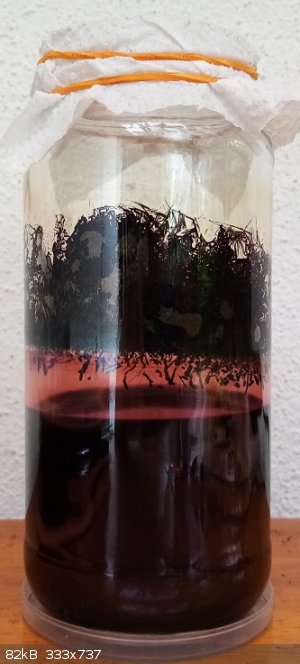
does anyone know of a way to stop crystals forming on the walls above the liquid level ?
as I assume they will be no more pure than the liquor below so a waste of evaporation time - which is already about a month.
(I'm hoping for at least one 'nice' crystal at the bottom of the jar, and I've distilled some sulphuric acid already).
can anyone give me a guestimate of how many times to recrystalise KMnO4 to obtain potassium permanganate pure enough for the experiment in
the thread that I pointed to above ?
CAUTION : Hobby Chemist, not Professional or even Amateur
|
|
|
AvBaeyer
National Hazard
   
Posts: 651
Registered: 25-2-2014
Location: CA
Member Is Offline
Mood: No Mood
|
|
Sulaiman,
Potassium permanganate needs to be recrystallized from water very quickly and with minimal light exposure. The compound will decompose in water on
long standing or excessive heating which you can note by a brown film on your recrystallization container. If you do not work fast, your sample will
contaminated with manganese dioxide (the brown color.)
According to Perrin and Amarego (Purification of Laboratory Chemicals):
1. Crystallize KMnO4 from hot water at 65 C using 4 ml per gram. filter then dry in a vacuum desiccator over CaSO4. [Though not mentioned, I assume
that the solution is cooled to ambient before filtration.]
2. Saturate an aqueous solution at 60 C, cool to room temperature in the dark the filter through a sinter glass funnel. Allow the filtrate to
evaporate in air in the dark for 12 hours, decant the supernatent from the crystals which are dried as quickly as possible on filter paper.
One thing seems to be clear - do not overheat and work quickly.
Hope this helps,
AvB
|
|
|
arkoma
Redneck Overlord
      
Posts: 1761
Registered: 3-2-2014
Location: On a Big Blue Marble hurtling through space
Member Is Offline
Mood: украї́нська
|
|
rosocyanine
Pictures from the other day.
https://en.wikipedia.org/wiki/Rosocyanine
Turmeric extract 91% IPA
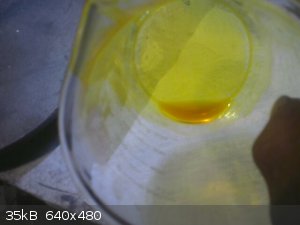
After gentle heating/stirring with Boric acid
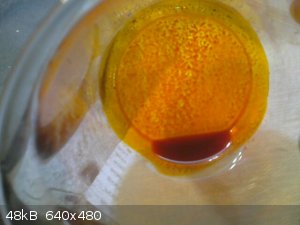
Hard to see the green of the Rosocyanine, but it's there
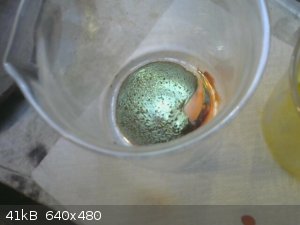
"We believe the knowledge and cultural heritage of mankind should be accessible to all people around the world, regardless of their wealth, social
status, nationality, citizenship, etc" z-lib
|
|
|
ChemTalk
Hazard to Self
 
Posts: 65
Registered: 13-12-2018
Location: United States
Member Is Offline
Mood: colloidal
|
|
We've been trying the reaction between potassium permanganate and hydrogen peroxide in a few slightly different ways.
It's a simple well-known reaction but we think it has a sweet spot in the category of easy yet somewhat dramatic reactions / experiments.
|
|
|
Piroz
Harmless

Posts: 19
Registered: 15-12-2020
Location: Poland
Member Is Offline
|
|
I started with winemaking (dog rose wine) as source of carbon dioxide. Few months ago I got by this way sodium bicarbonate and ammonium bicarbonate
(and got some apple cider by the way). Now it's time to potassium bicarbonate from wood ash extract, it's needed for purification of potassium
compounds from ashes- by crystallisation of KHCO3.
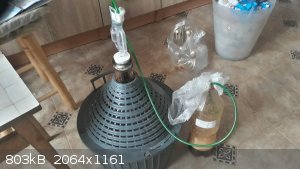 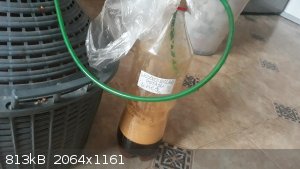 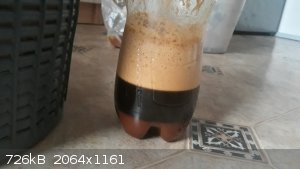
[Edited on 24-1-2021 by Piroz]
|
|
|
arkoma
Redneck Overlord
      
Posts: 1761
Registered: 3-2-2014
Location: On a Big Blue Marble hurtling through space
Member Is Offline
Mood: украї́нська
|
|
clobbered together a small electric furnace this afternoon. can finally have some CaO; have some lime in it now.
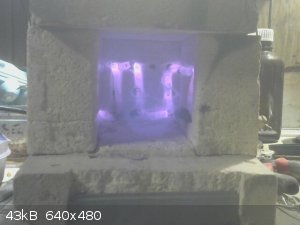 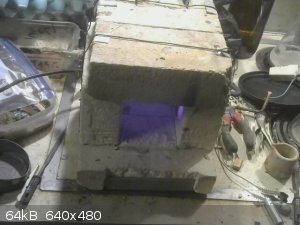 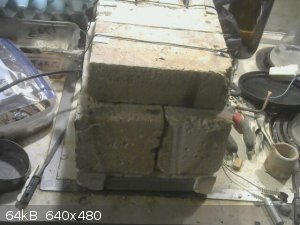
[Edited on 1-30-2021 by arkoma]
"We believe the knowledge and cultural heritage of mankind should be accessible to all people around the world, regardless of their wealth, social
status, nationality, citizenship, etc" z-lib
|
|
|
| Pages:
1
..
7
8
9
10
11
..
14 |